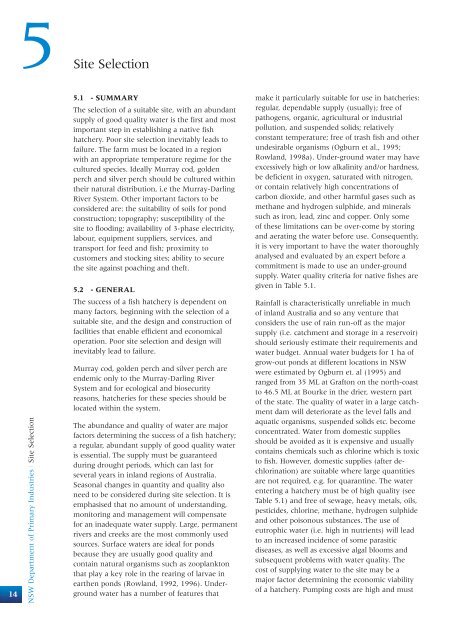Hatchery Quality Assurance Program - NSW Department of Primary ...
Hatchery Quality Assurance Program - NSW Department of Primary ...
Hatchery Quality Assurance Program - NSW Department of Primary ...
You also want an ePaper? Increase the reach of your titles
YUMPU automatically turns print PDFs into web optimized ePapers that Google loves.
5 Site<br />
Selection<br />
14<br />
<strong>NSW</strong> <strong>Department</strong> <strong>of</strong> <strong>Primary</strong> Industries | Site Selection<br />
5.1 - SUMMARY<br />
The selection <strong>of</strong> a suitable site, with an abundant<br />
supply <strong>of</strong> good quality water is the first and most<br />
important step in establishing a native fish<br />
hatchery. Poor site selection inevitably leads to<br />
failure. The farm must be located in a region<br />
with an appropriate temperature regime for the<br />
cultured species. Ideally Murray cod, golden<br />
perch and silver perch should be cultured within<br />
their natural distribution, i.e the Murray-Darling<br />
River System. Other important factors to be<br />
considered are: the suitability <strong>of</strong> soils for pond<br />
construction; topography; susceptibility <strong>of</strong> the<br />
site to flooding; availability <strong>of</strong> 3-phase electricity,<br />
labour, equipment suppliers, services, and<br />
transport for feed and fish; proximity to<br />
customers and stocking sites; ability to secure<br />
the site against poaching and theft.<br />
5.2 - GENERAL<br />
The success <strong>of</strong> a fish hatchery is dependent on<br />
many factors, beginning with the selection <strong>of</strong> a<br />
suitable site, and the design and construction <strong>of</strong><br />
facilities that enable efficient and economical<br />
operation. Poor site selection and design will<br />
inevitably lead to failure.<br />
Murray cod, golden perch and silver perch are<br />
endemic only to the Murray-Darling River<br />
System and for ecological and biosecurity<br />
reasons, hatcheries for these species should be<br />
located within the system.<br />
The abundance and quality <strong>of</strong> water are major<br />
factors determining the success <strong>of</strong> a fish hatchery;<br />
a regular, abundant supply <strong>of</strong> good quality water<br />
is essential. The supply must be guaranteed<br />
during drought periods, which can last for<br />
several years in inland regions <strong>of</strong> Australia.<br />
Seasonal changes in quantity and quality also<br />
need to be considered during site selection. It is<br />
emphasised that no amount <strong>of</strong> understanding,<br />
monitoring and management will compensate<br />
for an inadequate water supply. Large, permanent<br />
rivers and creeks are the most commonly used<br />
sources. Surface waters are ideal for ponds<br />
because they are usually good quality and<br />
contain natural organisms such as zooplankton<br />
that play a key role in the rearing <strong>of</strong> larvae in<br />
earthen ponds (Rowland, 1992, 1996). Underground<br />
water has a number <strong>of</strong> features that<br />
make it particularly suitable for use in hatcheries:<br />
regular, dependable supply (usually); free <strong>of</strong><br />
pathogens, organic, agricultural or industrial<br />
pollution, and suspended solids; relatively<br />
constant temperature; free <strong>of</strong> trash fish and other<br />
undesirable organisms (Ogburn et al., 1995;<br />
Rowland, 1998a). Under-ground water may have<br />
excessively high or low alkalinity and/or hardness,<br />
be deficient in oxygen, saturated with nitrogen,<br />
or contain relatively high concentrations <strong>of</strong><br />
carbon dioxide, and other harmful gases such as<br />
methane and hydrogen sulphide, and minerals<br />
such as iron, lead, zinc and copper. Only some<br />
<strong>of</strong> these limitations can be over-come by storing<br />
and aerating the water before use. Consequently,<br />
it is very important to have the water thoroughly<br />
analysed and evaluated by an expert before a<br />
commitment is made to use an under-ground<br />
supply. Water quality criteria for native fishes are<br />
given in Table 5.1.<br />
Rainfall is characteristically unreliable in much<br />
<strong>of</strong> inland Australia and so any venture that<br />
considers the use <strong>of</strong> rain run-<strong>of</strong>f as the major<br />
supply (i.e. catchment and storage in a reservoir)<br />
should seriously estimate their requirements and<br />
water budget. Annual water budgets for 1 ha <strong>of</strong><br />
grow-out ponds at different locations in <strong>NSW</strong><br />
were estimated by Ogburn et. al (1995) and<br />
ranged from 35 ML at Grafton on the north-coast<br />
to 46.5 ML at Bourke in the drier, western part<br />
<strong>of</strong> the state. The quality <strong>of</strong> water in a large catchment<br />
dam will deteriorate as the level falls and<br />
aquatic organisms, suspended solids etc. become<br />
concentrated. Water from domestic supplies<br />
should be avoided as it is expensive and usually<br />
contains chemicals such as chlorine which is toxic<br />
to fish. However, domestic supplies (after dechlorination)<br />
are suitable where large quantities<br />
are not required, e.g. for quarantine. The water<br />
entering a hatchery must be <strong>of</strong> high quality (see<br />
Table 5.1) and free <strong>of</strong> sewage, heavy metals, oils,<br />
pesticides, chlorine, methane, hydrogen sulphide<br />
and other poisonous substances. The use <strong>of</strong><br />
eutrophic water (i.e. high in nutrients) will lead<br />
to an increased incidence <strong>of</strong> some parasitic<br />
diseases, as well as excessive algal blooms and<br />
subsequent problems with water quality. The<br />
cost <strong>of</strong> supplying water to the site may be a<br />
major factor determining the economic viability<br />
<strong>of</strong> a hatchery. Pumping costs are high and must

















